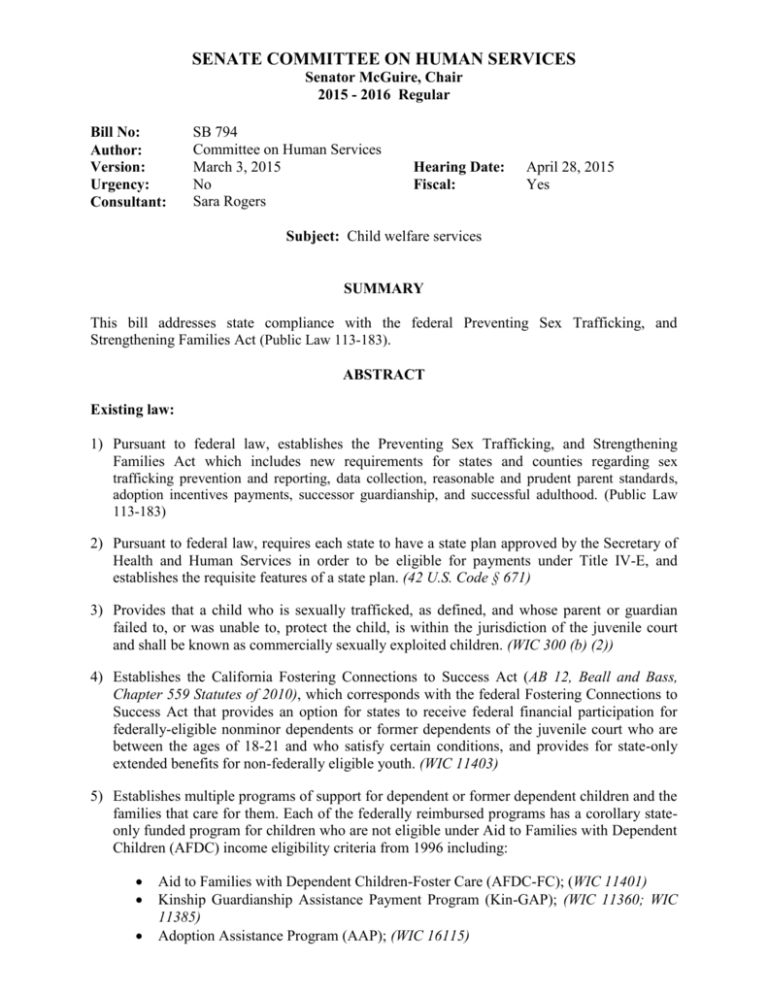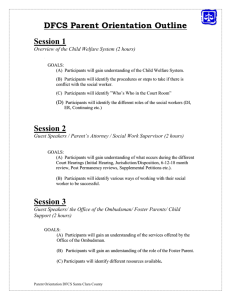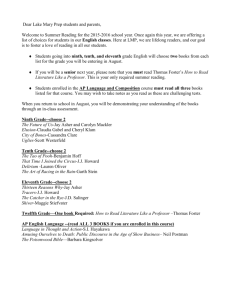
SENATE COMMITTEE ON HUMAN SERVICES
Senator McGuire, Chair
2015 - 2016 Regular
Bill No:
Author:
Version:
Urgency:
Consultant:
SB 794
Committee on Human Services
March 3, 2015
No
Sara Rogers
Hearing Date:
Fiscal:
April 28, 2015
Yes
Subject: Child welfare services
SUMMARY
This bill addresses state compliance with the federal Preventing Sex Trafficking, and
Strengthening Families Act (Public Law 113-183).
ABSTRACT
Existing law:
1) Pursuant to federal law, establishes the Preventing Sex Trafficking, and Strengthening
Families Act which includes new requirements for states and counties regarding sex
trafficking prevention and reporting, data collection, reasonable and prudent parent standards,
adoption incentives payments, successor guardianship, and successful adulthood. (Public Law
113-183)
2) Pursuant to federal law, requires each state to have a state plan approved by the Secretary of
Health and Human Services in order to be eligible for payments under Title IV-E, and
establishes the requisite features of a state plan. (42 U.S. Code § 671)
3) Provides that a child who is sexually trafficked, as defined, and whose parent or guardian
failed to, or was unable to, protect the child, is within the jurisdiction of the juvenile court
and shall be known as commercially sexually exploited children. (WIC 300 (b) (2))
4) Establishes the California Fostering Connections to Success Act (AB 12, Beall and Bass,
Chapter 559 Statutes of 2010), which corresponds with the federal Fostering Connections to
Success Act that provides an option for states to receive federal financial participation for
federally-eligible nonminor dependents or former dependents of the juvenile court who are
between the ages of 18-21 and who satisfy certain conditions, and provides for state-only
extended benefits for non-federally eligible youth. (WIC 11403)
5) Establishes multiple programs of support for dependent or former dependent children and the
families that care for them. Each of the federally reimbursed programs has a corollary stateonly funded program for children who are not eligible under Aid to Families with Dependent
Children (AFDC) income eligibility criteria from 1996 including:
Aid to Families with Dependent Children-Foster Care (AFDC-FC); (WIC 11401)
Kinship Guardianship Assistance Payment Program (Kin-GAP); (WIC 11360; WIC
11385)
Adoption Assistance Program (AAP); (WIC 16115)
SB 794 (Committee on Human Services)
Page 2 of 8
Non Relative Legal Guardianship (NRLG); (WIC 11405)
CalWORKs (for non-Title IV-E eligible children in foster care residing with
relatives). (WIC 11250)
6) Defines a “reasonable and prudent parent standard” as the standard characterized by careful
and sensible parental decisions that maintain the child’s health, safety, and best interest.
(WIC 362.04)
7) Provides that every dependent child shall be entitled to participate in age-appropriate
extracurricular, enrichment, and social activities, as specified. Requires group homes and
specified caregivers to use the reasonable and prudent parent standard in determining
whether to permit a child to participate in extracurricular, enrichment, and social activities.
(WIC 362.05)
8) Requires, upon the 16th birthday of a child in foster care, a county welfare or probation
department to request a free annual credit check available under the Fair Credit Reporting
Act, from each of the three major credit reporting agencies and for specified documentation
pertaining to this requirement be included in the youth’s case plan, as specified. (WIC
10618.6(a) and 16501.1)
This bill:
1) Requires licensed community care facilities that provide care and supervision to children to
designate at least one onsite staff member to apply the reasonable and prudent parent
standards, as specified.
2) Requires a licensed or certified foster parent or facility staff member to receive training
related to the reasonable and prudent parent standard, including knowledge and skills relating
to the standard for the participation of the child in age and developmentally appropriate
activities, as specified.
3) Amends the definition of the reasonable and prudent parent standard to mean the standard
characterized by careful and sensible parental decisions that maintain the health, safety, and
best interests of a child while at the same time encouraging the emotional and developmental
growth of the child.
4) Expands the definition of sexual exploitation to include a person who sexually trafficks a
child or commercially sexually exploits a child, as specified.
5) Requires county probation or child welfare agencies to immediately notify the appropriate
law enforcement authority when a child or youth who is receiving child welfare services and
is known or suspected to be the victim of sexual exploitation is missing or has been abducted,
so that the incident can be entered into the National Crime Information Center database of
the FBI and to the National Center for Missing and Exploited Children.
6) Requires the California Department of Social Services (CDSS) to inquire about a dependent
child’s credit history at the age of 14 instead of 16 and for specified documentation to be
included in a case plan of a youth 14 years of age or older.
7) Provides that a successor kinship guardian or co-guardian may be appointed by the juvenile
court only when the reason for the appointment is the death or incapacity of the kinship
SB 794 (Committee on Human Services)
Page 3 of 8
guardian and the successor guardian is named in the kinship guardianship assistance
agreements, as specified.
8) Clarifies that the foster care education training programs provided to relative and nonrelative
extended family members under current law are aligned with the training requirements
established for licensed or certified foster parents, and include training on the reasonable and
prudent parent standard, provided for in the bill.
9) Requires no less than 30 percent of savings realized from the provision of new federal
funding for adoption assistance resulting from the Fostering Connections to Success and
Increasing Adoptions Act of 2008 shall be spent on post-adoption services, post-guardianship
services, and services to support and sustain positive permanent outcomes for children who
otherwise might enter into foster care.
10) Requires at least two-thirds of the above 30 percent to be spent on post adoption and post
guardianship services.
11) Adds to the requirement to reinvest adoption incentive payments, the requirement to require
reinvest guardianship incentive payments received through the Fostering Connections to
Success and Increasing Adoptions Act of 2008 and the Preventing Sex Trafficking, and
Strengthening Families Act into the child welfare system, as specified.
12) Replaces the term “independent living” with “successful adulthood” in describing
requirements pertaining to a nonminor dependent’s case plan.
13) Provides that for youth 14 years of age or older, the youth’s case plan shall be developed in
consultation with the youth. Provides that, at the youth’s option, the consultation may include
up to two members of the case planning team who are chosen by the youth, as specified.
Permits the child welfare agency to reject an individual under specified circumstances.
14) Provides that for youth 14 years of age or older, the case plan shall include the following:
A document that describes the youth’s rights with respect to education, health,
visitation and court participation, the right to be annually provided with copies of his
or her credit reports at no cost while in foster care, and the right to stay safe and avoid
exploitation.
A signed acknowledgement by the youth that he or she has been provided a copy of
the document and that the rights described in the documents have been explained to
the youth in an age-appropriate manner.
15) Requires a case plan for a child or nonminor dependent who is, or is at risk of becoming, the
victim of commercial sexual exploitation, to document the services provided to address that
issue.
16) Requires county child welfare agencies to develop and implement policies and procedures
that, at a minimum, require social workers and probation officers to do the following:
Identify children receiving child welfare services, including dependents or wards in
foster care, nonminor dependents, and youth receiving services under the John H.
Chafee Foster Care Independence Program.
SB 794 (Committee on Human Services)
Page 4 of 8
Document the individuals identified in the Child Welfare Services/Case Management
System and any other agency record as determined by the county.
Determine appropriate services for a child identified.
17) Requires county child welfare agencies, on or before July 1, 2016, to develop and implement
specific protocols to expeditiously locate any child missing from foster care. Specifically
requires these protocols, at a minimum to do the following:
Determine the primary factors that contributed to the child or nonminor dependent
running away or otherwise being absent from care.
Respond to those factors in subsequent placements, to the extent possible.
Determine the child’s or nonminor’s experiences while absent from care.
Determine whether the child or nonminor is a possible sex trafficking victim.
18) Requires CDDS to ensure the Child Welfare Services/Case Management System is capable
of collection all of the following:
The number of dependent children or wards in foster care who were victims of
commercial sexual exploitation before entering foster care.
The number of dependent children or wards in foster care who became victims of
commercial sexual exploitation while in foster care.
The numbers of dependent children or wards in foster care who go missing, run away,
or are otherwise absent from care and were commercially sexually exploited during
the time away from placement.
The number of dependent children or wards in foster care who are at risk of becoming
victims of commercial sexual exploitation.
FISCAL IMPACT
This bill has not been analyzed by a fiscal committee.
BACKGROUND AND DISCUSSION
Purpose of the bill:
According to the authors, this bill makes statutory changes necessary to ensure state compliance
with the federal Preventing Sex Trafficking, and Strengthening Families Act (Public Law 113183) as identified by the California Department of Social Services.
The committee states that every year the California Department of Social Services (CDSS) must
ensure that state laws pertaining to adult programs, children and family services, community care
licensing, human rights, state hearings, and Temporary Assistance for Needy Families are in
compliance with federal statute and regulations. When CDSS determines that existing state
statute is out of compliance, legislation is introduced to conform state law to federal
requirements. Last year the Senate Committee on Human Services introduced federal compliance
bill SB 1460 (Committee on Human Services, Chapter 772, Statutes of 2014) that ensured state
compliance with federal statute and regulation regarding the Multi Ethnic Placement Act, use of
the Federal Parent Locator Service, the federal Fostering Connections to Success and Increasing
Adoptions Act of 2008, and the Adam Walsh Act.
SB 794 (Committee on Human Services)
Page 5 of 8
Commercially Sexually Exploited Children (CSEC)
Commercial sexual exploitation of children is defined as the sexual exploitation of children at
least primarily for financial or other economic reasons. Under this definition, the economic
exchanges may be either monetary or non-monetary (i.e., for food, shelter, drugs).1 Sex
trafficking of minors is defined as the “recruitment, harboring, transportation, provision, or
obtaining of a person for the purpose of a commercial sex act” where the person is a U.S. citizen
or lawful permanent resident under the age of 18.2
The California Child Welfare Council, in a March 2013 report, states that children who fall
victim to commercial sexual exploitation frequently are involved with the child welfare system.
Specifically, the report states that 50 to 80 percent of CSEC are or were involved in the child
welfare system. Recent news reports quote the northern California FBI task force on trafficked
minors as estimating that 90 percent of recovered trafficked youth in northern California were
involved with the child welfare system. Additionally, the report states that youth in the child
welfare system are particularly vulnerable to commercial sexual exploitation. Children who
become victims of such exploitation frequently have a history of suffering physical and
emotional abuse, which led to their contact with the child welfare system. This abuse and neglect
combined with unstable placements in foster care and a frequent absence of positive and loving
adult relationships create emotional vulnerabilities that are exploited. On average, early
adolescence is the most common age for children to fall victim to commercial sexual exploitation
- between ages 11 to 13 for boys and ages 12 to 14 for girls.
The report cites research finding that 68 percent of victims of CSEC suffered from chronic health
problems and Post-Traumatic Stress Disorder and likened the experience of victims to
experiences of “hostages, prisoners of war, or concentration camp inmates.”
The Preventing Sex Trafficking, and Strengthening Families Act
The Preventing Sex Trafficking, and Strengthening Families Act (Public Law 113-183) was
signed by the President on September 29, 2014. The Act makes numerous changes to the title IV-E
foster care program and enacts new requirements regarding sex trafficking prevention and
reporting, data collection, reasonable and prudent parent standards, adoption incentives payments,
successor guardianship, and successful adulthood.
Sex Trafficking Prevention and Data Collection
According to the federal Administration for Children and Families,3 the new law requires title IV-E
agencies to demonstrate, by September 29, 2015, that policies and procedures have been developed
to identify, document, and determine appropriate services for a child or nonminor dependent who is
or who is at risk of becoming a sex trafficking victim, has run away from home, or is receiving
services under the Chafee Foster Care Independence Program. By September 29, 2016, state agencies
must demonstrate that they are implementing these policies and procedures.
Estes and Weiner. “The Commercial Sexual Exploitation of Children in the U. S., Canada and Mexico.” Univ. of
PA, 2002. http://www.sp2.upenn.edu/restes/CSEC_Files/Exec_Sum_020220.pdf
2
Smith et al. “The National Report on Domestic Minor Sex Trafficking: America’s Prostituted Youth.” Shared
Hope Int’l, 2009.
http://sharedhope.org/wp-content/uploads/2012/09/SHI_National_Report_on_DMST_2009.pdf
1
3
ACYF-CB-IM-14-03 October 23, 2014
SB 794 (Committee on Human Services)
Page 6 of 8
Also by September 29, 2015, title IV-E agencies must develop and implement protocols to locate
children and nonminor dependents missing from foster care, determine the factors that lead to the
youth’s absence from foster care and, to the extent possible, address those factors in subsequent
placements, determine the youth’s experiences while absent from care, including whether the youth
is a sex trafficking victim, and report related information as required by HHS.
By September 29, 2016, the Act also requires title IV-E agencies to report immediately (no later than
24 hours) to law enforcement when a child or nonminor dependent is identified to be a victim of sex
trafficking. Additionally, by the same year, agencies must develop and implement protocols to report
immediately (no later than 24 hours after receiving information) to law enforcement, information on
missing or abducted youth receiving child welfare services who are identified as being, or are at risk
of being, a victim of sex trafficking, for entry into the National Crime Information Center (NCIC)
database, and to the National Center for Missing and Exploited Children.
SB 855 (Budget and Fiscal Review Committee, Chapter 29, Statutes of 2014) provided $5 million
initially, and $14 million General Fund ongoing, to enable county child welfare agencies to provide
services to child victims of commercial sexual exploitation to enable county child welfare agencies to
serve victims of commercial sexual exploitation.
Reasonable and Prudent Parent Standards (RPPS)
Existing state statute provides for a reasonable and prudent parent standard that serves to guide
caregiver’s day-to-day decision making to ensure youth in their care are safely able to participate in
important age and developmentally important activities such as extracurricular events or visiting
friends. The Act adds new staffing requirements for group homes and training for group home
staff and foster family homes. Specifically, SB 794 requires the following:
Training for all foster parents to include training on RPPS.
All foster family homes and congregate care facilities to permit the use of RPPS.
Each congregate care facility to designate an onsite staff member to exercise RPPS
for foster children in the facility, who would receive the same RPPS training as foster
parents.
Additionally, SB 794 would align the definition of RPPS in state statute with the federal
definition and would enact training and staff designation requirements that conform to the above
federal requirements.
Another Planned Permanent Living Arrangement (APPLA)
APPLA is an out of home placement type referring to long-term foster care placement when the
youth is expected to remain until adulthood. It is intended to be identified as the permanency option
as a last resort, only when other options such as reunification, relative placement, adoption, or legal
guardianship have been ruled out.
The Act adds new case plan and case review system requirements for youth with Another Planned
Permanent Living Arrangement, prohibiting the use of APPLA for dependent children under the age
of 16 and adding case review and case plan requirements on its use for youth age 16 and older to
ensure efforts to place youth permanently with a parent, relative or in guardianship or adoptive
placement are documented.
Specifically, the Act requires child welfare agencies to document at each permanency hearing, the
efforts to place a child permanently with a parent, relative, or in a guardianship or adoptive home. It
SB 794 (Committee on Human Services)
Page 7 of 8
also requires child welfare agencies to implement procedures ensuring that the court or
administrative body conducting the permanency hearing asks the child about his/her desired
permanency outcome and makes a judicial determination at each permanency hearing that APPLA is
the best permanency plan for the child and to identify compelling reasons why it’s not in the best
interest of the child to be placed permanently with a parent, relative, or in a guardianship or adoptive
placement.
This bill currently does not amend statutes pertaining to these provisions, but the author states such
amendments may be forthcoming.
Adoption Incentives Payment Program
Under the Adoption Incentives program, states earn federal bonuses when they increase
adoptions of children in foster care above a 2007 FY baseline. Under the current Adoption
Incentive bonus structure, states earn $4,000 for each adoption of a foster child that is above the
number of foster child adoptions finalized by the state in FY 2007 and $8,000 for each adoption
of a child 9 years or older, above the number of older child adoptions it finalized in FY 2007.
Title IV-E agencies are required to reinvest the savings for the provision of foster care and
adoption services per mandates in the Act. Specifically, state statute would recognize the
Preventing Sex Trafficking and Strengthening Families Act and would reinvest adoption and
guardianship incentive payments to fund post-adoption and guardianship services.
California has not received any incentive payments since 2008.4 The state’s baseline in 2007 was
7,622 children, and has decreased substantially since then, reportedly due to the state’s overall
decline in the number of foster youth since 2007. Since the incentives payment methodology is
calculated based on the outright increase in number of adoptions following the 2007 baseline,
instead of based on the ratio of children in foster care to adoptions, California is not expected to
receive an incentive payment in the near future.
Successor Kin-GAP Guardian
Kinship Guardianship Assistance Payment (Kin-GAP) provides eligible relative legal guardians
a subsidy that is equal to the basic foster care rate. To be eligible for the program, the child must
have been placed with the relative caregiver for at least twelve consecutive months as a
dependent or delinquent child, legal guardianship must be established with the relative caregiver,
and dependency must be dismissed at the same time or after the establishment of the legal
guardianship by the Juvenile Court.
Federal law permits states to receive federal reimbursement under the Kin-GAP program for
Title IV-E eligible relative legal guardians. Prior to the federal Act, this program was solely state
funded. Relative legal guardians who are not Title IV-E eligible remain in the state-only
program. Kin-GAP guardians must wait a minimum of six months and until dependency is
terminated and guardianship established prior to receiving Kin-GAP payments. During that time,
relatives receive a child-only CalWORKs reimbursement of approximately $369 per month.
Under the federal Act, foster youth who move into Kin-GAP are eligible for extended foster care
benefits only if the youth was older than age 16 at the time that a Kin-GAP agreement was
negotiated. Similarly, the Adoption Assistance Program provides a federally funded subsidy for
4
http://www.fas.org/sgp/crs/misc/R43025.pdf
SB 794 (Committee on Human Services)
Page 8 of 8
Title IV-E eligible families or a state-funded subsidy for families not eligible for Title IV-E. As
is the case for Kin-GAP, youth are eligible for extended foster care benefits only if they entered
the adoption assistance program after turning 16.
Existing state law permits a foster youth receiving Kin-GAP to have a new “alternative or coguardian” established without having to wait six months if the new guardian has been assessed
by the court and child welfare agency, as specified. The Act allows continued eligibility of a
successor guardian when the previous relative guardian dies or is incapacitated. This bill narrows
state statute to allow a successor guardian, who is also a kinship guardian, to receive Kin-GAP
only if the prior kinship guardian dies or is incapacitated.
Successful Adulthood
The Act extends case plan requirements under the Chaffee Independent Living Program and
replaces the outcome of “independent living” with “successful adulthood.”
Under the Act, a case plan of a child age 14 or older must document the child’s education, health,
visitation, and court participation rights, the right to receive a credit report annually, and a signed
acknowledgement that the child was provided these rights and that they were explained in an age
appropriate way. Additionally, the case plan must be developed in consultation with the child, and at
the option of the child, include two members of the case planning team, who are not the caseworker
or foster parent. The case plan and permanency hearing must describe the services to help the youth
transition to successful adulthood (formerly at age 16), and the child welfare agency must provide a
copy of his/her credit report annually and assistance in fixing any inaccuracies (formerly age 16)
Related legislation:
SB 855 (Budget and Fiscal Review Committee, Chapter 29, Statutes of 2014) provided $5 million
initially, and $14 million General Fund ongoing, for county child welfare agencies to provide
services to child victims of commercial sexual exploitation.
SB 1460 (Committee on Human Services, Chapter 772, Statutes of 2014) that ensured state
compliance with federal statute and regulation regarding the Multi Ethnic Placement Act, use of
the Federal Parent Locator Service, the federal Fostering Connections to Success and Increasing
Adoptions Act of 2008, and the Adam Walsh Act
POSITIONS
Support:
District Attorney of Alameda County
Junior League of San Diego
Opposition:
None.
-- END --







